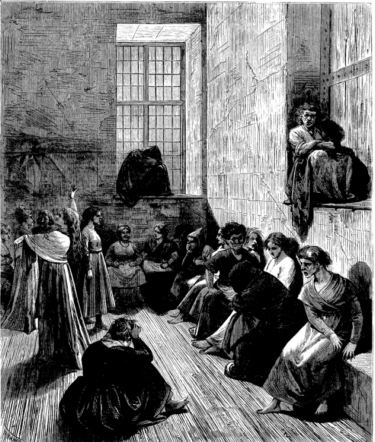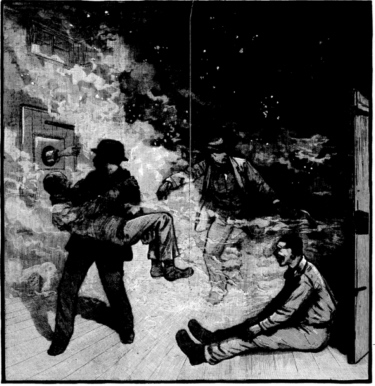RICHMOND COUNTY HOMES FOR THE POOR & INFIRM
From the Research of May MacCallum, Richmond County Historical Society
 |
Poor Houses were often called Poor Farms, and several similar terms, or referred to with the older term – Almshouses. These houses were tax-supported residential institutions to which people were required to go if they could not support themselves. They were started as a method of providing a less expensive (to the taxpayers) alternative to what we would now days call "welfare". People requested help from the community Overseer of the Poor (sometimes called Poor Master), an elected town official. If the need was great or likely to be long-term, they were sent to the poorhouse instead of being given relief while they continued to live independently. Sometimes they were sent there even if they had not requested help from the Overseer of the Poor. That was usually done when they were found guilty of begging in public, etc. Historical Overview of the American Poorhouse System At the April term, 1851 at the Court of Pleas and Quarter Sessions of Richmond County, an order was drawn empowering the Board of Wardens to purchase suitable land within five miles of Rockingham, and not nearer than one and a half miles, for the purpose of erecting thereon buildings to care for the aged and infirm of the county. The order was signed by the Clerk of Court, M.L. Douglas. One hundred thirty two acres were bought about two miles from the city, east, and entry dated 13th October 1851, is recorded on the Register of Deeds Book showing that the proper survey of this land had been made by the County Surveyor, W.W. Graham (father of N.A. Graham, the present County Surveyor.) It is presumed the buildings were shortly thereafter erected. Richmond County Post Dispatch Dec 31, 1925. At least six houses for the poor were built between October 1851 and 8th August 1860. The 1860 United States Federal Census for Richmond County, Wolf Pit District, Dwelling #557 shows John Taylor 33, b. NC, Keeper of the Poor House, Mary Jane Taylor, wife, 21; Christopher C. Taylor 2 yrs, and Mary Nicholson 65, b. Scotland, Pauper. It is not known exactly how long John A. Taylor served as Keeper of the Poor House. In addition to Christopher Columbus Taylor b. 1858, John and Mary J. would become parents of Nancy J., b.1860; Mary Taylor b. 1862; Martha Taylor b. 1863; John M. Taylor b. 1865; and Caroline Taylor b. 1867. Residents of the five Poor Houses #558, #559, #560 #561 and #562 are shown at "County Home Residents Buried Potters Field". In July 1870 there were three houses for the poor in Rockingham Township. Dwelling #60 shows Joseph Smith 58, Keeper of the Poor House; Nancy Smith 54; Mary Smith 17; and Nancy Smith 12; Dwellings #61 & #62 are poor houses showing residents. The 1880 Federal Census of Rockingham, Richmond County, Dwelling #66: Alamander Taylor 51, Keeper for House, Marthey 48, wife; Mary Taylor 50, sister; Noah Taylor 15, (b) servant; Dwelling #67 shows several residents of Poor House. Note: You must not call it "Poor House, now, but the Home for the Aged and Infirm." That's what the last legislature ordered. Source: THE ROCKET - October 3, 1891. Up until 1892 the superintendents of the Home were paid a certain amount for each resident, but after that time, when J.A. McNair became superintendent, the method was changed and the superintendent was paid a salary and the expenses paid by the county. McNair served for six years, and was followed by T.J. Gibson. R.L. McDonald served for one year and was followed by Temple Gibson for a year. Dave Sedberry served next, for four years, followed by John Hadley, for two. J.W. O'Brien came next with five 3 to 4 years tenure, and W.T. Baldwin came September 1st, 1912. He was followed about five years ago by the present very efficient Superintendent H.G. McLean. Source: Richmond County Post Dispatch December 31, 1925.
 |
Feeling that the old farm and buildings were inadequate, the Board of County Commissioners, consisting of H.E. Gibbons, Chairman, H.J. Rogers, J.L. Baldwin, J.R. Bennett and W. A. Gibson, on September 14,1916 bought from Mrs. W.B. Stansill and daughters for $1800 thirty acres of land one mile southeast of the city, adjacent to the Hamlet-Rockingham road and just one mile from the old Home. The old Home tract was thereupon sold to W.T. Baldwin for $2500. On April 15, 1917, the new Board of Commissioners, consisting of J.R. Bennett, Chairman, Dr. A.C. Everett, N.D. McDonald, J.L. Baldwin and James A. McNeill, contracted with A.D. Dumas for the erection of the present buildings. The job was completed in the Spring of 1918 and cost $18,500. The buildings were equipped with a central heating system bringing the total cost to approximately $22,000. The buildings are three in number and of brick. They face the south, and are 200 feet from the Hamlet-Rockingham highway, in plain view of it, and exactly one mile from the city limits at Falling Creek bridge. The central building is of two stories, the upper story being for the superintendent's family. The main dining rooms are on the first floor, the dining room for the whites on the west side, and the colored on the east side; the kitchen is in the middle. The build- ing on the west side, facing, is for white residents. The front is for the men, and the rear for the women; the building on the east side is for the colored residents. Each building is equipped with steam heat, and lavatories and toilets in each building, with running water. Covered walk-ways connect the three buildings. The farm consists of 30 acres, and the county furnishes the superintendent a horse for farming and gardening. To the east of the buildings, abt. 200 ft. is a large barn. The buildings face the hard surface highway, Route 20, and are on a gentle elevation, with perfect drainage, and have a commanding view. Many shade and fruit trees have been planted in the surroundings, and every effort is made to make the aged and infirm as comfortable as possible, combined with economy and simple living. It is presumed the County Commissioners will speedily make plans for rebuilding the burned building, and no doubt arrangements will be made for installing a hydrant there, tapping the Hamlet-Rkhm water line that passes 200 feet distant, so that should a fire ever occur again there will be means at hand for fighting it. Source: Richmond County Post Dispatch 1925.Go to Remembering County Homes #1 and #2
Go to County Home Residents Buried Potters Field
Go to Wardens of County Homes
Go to Fire Damages County Home
Return to What's New in Richmond County
Contact: Myrtle Bridges, NCGenWeb Coordinator for Richmond County ©Copyright January 14, 2014 by Myrtle N. Bridges